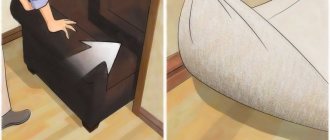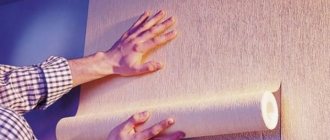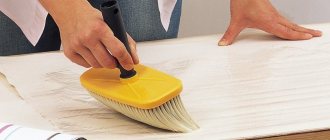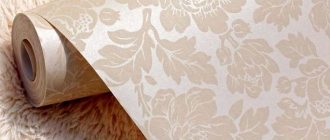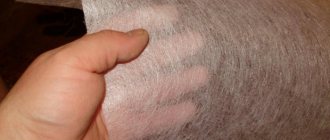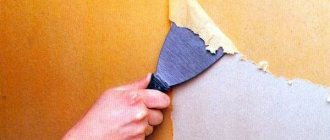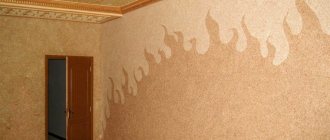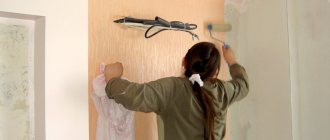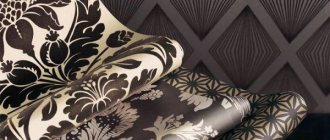With natural coatings, the interior is enlivened by a variety of colors and textures. To get in touch with nature, it will be enough to touch a wall decorated with such a coating. This finish will be greeted with great enthusiasm by pets who will immediately try to use the coating for their needs. Already from the name it follows that wallpaper made from natural plant materials has the highest degree of environmental safety, which allows it to be used without reservations for decorating children's rooms.
Natural wall coverings: finishing features
Content
The main feature of coatings made from plant materials is the use of manual labor for most of the operations in the manufacturing process. In this regard, the price of the material is quite high. But they're worth it.
First, the desired plants are collected and washed. After drying in the sun, the collection is sorted by color and size. Using special threads from selected plants, either by machine or by hand, weave fabrics that are glued to a paper backing or non-woven wallpaper. The presence of seams on the surface shows that it is woven by hand.
♥See also the photo gallery on the website “Washable decorative plaster”
Types of natural wallpapers and their main characteristics
There is a large number of natural wallpapers, which are distinguished by manufacturing technology and materials used. The most common types are:
- made of natural wood;
- with a plant base;
- with bamboo inclusions;
- cork (made from natural cork);
- with leaves.
Wallpaper made of natural wood
Paper is used as the basis for such wallpaper. The top layer is made from thin sections of various tree species. The cut itself is so thin that it is practically indistinguishable from ordinary paper.
Wallpaper made from mahogany, rosewood, teak and other exotic species are considered especially popular.
They create a healthy microclimate in the room, are durable and easy to maintain. Due to the variety of textures, they are suitable for decorating living rooms, bedrooms and even children's rooms.
Plant based wallpaper
This type of wallpaper is made from sisal or jute. Paper or non-woven fabric is used as a backing. Strict geometric patterns or chaotic patterns are created from plant fibers, depending on the manufacturer. Regardless of the ornament, the outer surface of such wallpaper looks very original and aesthetically pleasing.
As a rule, this wallpaper is used to paste over walls or make fragmentary panels; it is also used for pasting ceilings and niches. They go well with simple paper wallpaper or sections of walls painted in natural colors. Most often used to decorate bedrooms or living rooms. The only drawback is that such wallpaper absorbs odors very quickly and is not recommended for kitchen decor.
Wallpaper with bamboo
Bamboo wallpaper is made from thin sections of bamboo, pressed at a certain temperature. They are baseless, uniform and practical. When making wallpaper from bamboo, dyes are almost never used, since their natural color spectrum is quite wide: from white-greenish to yellow-brown.
Sometimes some manufacturers coat the outer layer with a protective clear varnish.
This type of wallpaper is considered the most popular and versatile. They are perfect for finishing any room, including the kitchen and bathroom, they are easy to clean and are not afraid of wet cleaning.
Cork wallpaper
This type of natural wallpaper is obtained thanks to particles of cork tree bark pressed using a special technology. They are durable and practical, regulate the humidity in the room, condensation does not settle on their surface, and are resistant to sudden temperature changes.
Their most unusual and paradoxical property is that they do not support combustion and can even prevent the spread of fire.
In addition, cork wallpaper is considered an excellent sound insulator, and it retains heat well. For such a wide range of advantages, they are popular with many people. They decorate any room, including the bathroom and kitchen.
Foliage wallpaper
This type of finishing materials appeared relatively recently. The basis of leaf wallpaper is thin paper, onto which real fallen or dried leaves, pre-treated with high-temperature steam, are glued.
The main disadvantage of this type of wallpaper is its fragility and fragility. With the slightest force applied, the top decorative layer crumbles. Due to their low wear resistance, they are used to create decorative panels and small inserts on the wall or ceiling. For obvious reasons, they are not used in the kitchen or bathroom.
Types of plant wallpapers
The richest in number of varieties are plant species:
- Natural jute fabrics - decoration with fibers from plants of the linden family. Since the fibers are arranged in the form of knots, a peculiar pattern is obtained on the surface. They are quite strong and wear-resistant, but they are well saturated with odors, so it is better not to glue them in the kitchen.
- Reed - with a base of papyrus or rice paper. The outer layer resembles threads extracted from the stems. They are made only by hand, so no two rolls are identical in color. They have good breathability and light fastness.
- Sisal - on a backing of unbleached paper. Threads of agave leaves are used for the top layer. The fabrics are very durable due to the rigidity of sisal fibers. They withstand changes in temperature and humidity perfectly.
- Linen is the cheapest model of this type. The top layer is decorated by laminating mixed threads, including metal ones. As a result, there are many areas with different shades on the canvas from one roll. These coatings are light-resistant, do not accumulate static electricity, and have good heat-insulating and sound-absorbing properties.
- Papyrus on thick paper with an outer layer of papyrus threads obtained from plants of the sedge family. Shiny paper is sometimes used as a backing, which is visible through the papyrus fibers. This type is waterproof, durable, and practical.
- Natural fabrics with leaves on a non-woven base. To create the outer layer, leaves of the bodhi tree, mango, Chinese nettle, ficus, and magnolia are used. To avoid premature leaf fall, it is better not to glue them in rooms where children and pets can enter uncontrollably.
Furniture made from unusual materials
Furniture made from unusual materials can be synthetic or environmentally friendly, completely natural. At the dacha or in a summer country garden, not only old pallets are relevant, but also rubber tires for furniture and children's swings. In the home, many people love antique wooden furniture, utensils made from Viennese straw, wall decor with natural mats, and the modern choice of finishing materials makes this possible. Moreover, the artistic range of finishes in raffia and bamboo, linen and cotton, rattan and felt is constantly expanding.
Vienna straw in the interior
Vienna straw is a special diagonal type of weaving - the fabric is quite strong, elastic and unusually beautiful. The Viennese straw was invented more than a century ago, and at one time decorated the boudoirs of queens and the rooms of rich burghers. Furniture craftsmen did not come up with the idea of the technology of bent wooden elements under the influence of steam and boiling water, but only reproduced them on new equipment. The birth of Viennese chairs with seats and backs woven from Viennese straw occurred in Germany, but according to historians, the ancient Egyptians had bent furniture elements made of wood.
The grace, subtle beauty and naturalness of straw weaving give modern interiors a special light charm, and the smooth curves of furniture legs and backs can be created not only from solid wooden elements, which is difficult and expensive, but from cheap rattan. This direction of furniture art has already won many fans around the world; rattan candlesticks and wicker wallpaper, partitions and furniture can be purchased ready-made and created with your own hands. Rough rattan and brutal bamboo have nothing to do with Viennese straw, and are completely incompatible, except that the idea of weaving from natural stems, straw and bark is the same. Wheat and rice straw for handicrafts are available today in many specialized hobby and handicraft stores, but manufacturers of mass products have long switched to rattan straw - strong, inexpensive, durable. You can have garden furniture from rattan, but real products made from straw are very expensive and are more elitist than democratic.
Synthetics in the form of Viennese straws are found in retro interiors and look very nice. But plastic imitations are far from the real branded weaving made from fragrant natural straw. The game is based on the recognizable appearance and ancient style of the Viennese straw, on its historical popularity and classical grace.
Vienna straw differs from other types of weaving by octagonal holes, which can be small or very large. Fine weaving is used for elegant decor, lampshades and wall decorations, fans, hats (straw hat is an old brand), and tableware. Large-format weaving can be used to create mesh elements for the seats of armchairs and chairs, for sofa and bed backrests.
Felt furniture
Poufs and felt pillows in the shape of huge sea pebbles - they are unusual in both shape and material, and the idea itself is unusual. Although it completely fits into the concept of naturalness in the interior and the use of natural materials in everyday life! Felt stones also support the idea of sustainability as a way to maintain environmental sustainability, an ecological approach to home design and the desire to use your household supplies, including furniture and utensils, for as long as possible - in order to protect nature and save its resources. A felt pouf is a healing, ergonomic and timeless piece of furniture; you simply cannot throw this soft miracle out of your home because it is “not fashionable.” More about felt stones: Unusual furniture
For lovers of unusual design
In addition to traditional species, there are also more exotic varieties of plant fabrics. They use steppe grass, seaweed, and vine fibers to decorate the outer layer. However, natural wooden coverings have become more widespread, as they are more practical, durable, and wear-resistant. For their manufacture the following is used:
- Natural bamboo coverings. The base is made of rice paper or fabric. For the outer layer, trunk fibers or pieces thereof are used. Available in the form of panels. This is the most durable wallpaper of this type with a service life of up to 40 years. It takes a lot of effort to damage them.
- Cork. The material has excellent soundproofing properties. Non-woven fabric or reinforced paper is used as a base. The bark of cork oak trees is used for the outer layer. Cork wallpaper is available in the form of rolls and sheets.
- Palm. For production, not fibers are used, but nut shells, which gives the wallpaper a high degree of strength and durability. A scattering of shells laid out in a certain order creates a contrasting surface. This variety is available exclusively in sheet form.
- Natural veneer wallpapers are made from valuable wood species. For the production of veneer, oak, cherry, and sandalwood are used. Depending on the method of obtaining veneer and gluing it, patterns from the same wood will turn out different. For light veneer, paper is used as a base, for heavy veneer, non-woven veneer is used.
♥For your attention, an article on the website “Floor with anti-slip effect”
Advantages of bamboo wallpaper
Bamboo wallpaper in the interior has many advantages compared to other finishing materials:
- They are environmentally friendly and safe. The main property of bamboo coatings is complete resistance to the development of harmful bacteria and protozoan microorganisms. This is the reason why they are often chosen for kitchens, bedrooms, children's rooms, wellness clinics, etc. They are great for people who suffer from various allergic diseases;
- They serve for a long time due to their stable color range and increased wear resistance. They are not afraid of high humidity or sudden temperature changes;
- A very profitable saving for those who do not intend to constantly engage in repairs. During the service they will fully recoup their initial cost. A very important detail - the walls do not need to be carefully leveled before gluing. The material is so flexible and thick that it will perfectly hide all imperfections;
- They are absolutely picky in their care. Easily wiped with a damp sponge. You can remove dust with a vacuum cleaner;
- They are easy to glue;
- Compatible with all styles and finishing materials. They can be used to cover walls and decorate furniture, window and door openings. Nature made sure that their designs were unique and had different tones.
The main advantages and disadvantages of wallpaper made from natural materials
Wall coverings with natural materials are famous for the following advantages:
- using plant-based, environmentally friendly materials;
- excellent appearance;
- they do not fade during their entire service life and do not fade in the sun;
- good sound insulation properties;
- supporting air exchange, which makes the walls “breathable”.
Unfortunately, there are also disadvantages, the main one being high cost. The strength is not high enough to withstand close contact with children and pets without damage. In terms of durability, they are significantly inferior to many types of vinyl wallpaper.
To increase service life, careful handling and avoidance of high humidity are necessary.
Kinds
There are 2 types of these products.
From the outer part of the trunk
They are produced from the upper part of the stem. Natural patterns, joints and texture are visible on the material. The following shades are found: chocolate, tortoiseshell, pistachio, green.
Chocolate-colored bamboo wallpaper in the hallway.
Tortoiseshell bamboo wallpaper.
From the inside of the trunk
The material appears after processing the inner surface of the bamboo trunk. The slats are carefully processed and polished to achieve a perfectly smooth surface. Then they are glued to a gauze base.
Combinations of bamboo and cane
The design can be presented in a composition of different textures. Externally, the plants are similar, but have different properties. Reed canvases tolerate light well, but are more susceptible to water. In the finishing product, stripes of reed and bamboo can alternate.
Bamboo fabric.
Reed fabric.
Reed interior.
Reasons for the popularity of finishing
After appearing on the market, wallpaper using natural materials quickly became bestsellers in most specialized stores. Such a rapid increase in popularity is explained by their environmental safety and extraordinary appearance, which creates an interesting design.
The uniqueness of the design is guaranteed by the natural materials themselves, which, even in the same variety, are not identical in color and pattern. Many types of natural wallpaper are equally good for finishing walls and ceilings.
- Plant wallpaper made from natural materials: photo gallery
It’s interesting to know about floral wallpapers from...To watch photos "
Raffia wallpaper: Natural Wallcoverings, Eijffinger brand
The Natural Wallcoverings catalog will delight all lovers of “breathable” walls. It presents mats of a wide variety of weaving, with large and small knots.
Eijffinger raffia wallpaper, Natural Wallcoverings catalog
The color range is also interesting: from the color of unbleached linen and ash to natural golden straw and inky black linens.
Eijffinger raffia wallpaper, Natural Wallcoverings catalog
Eijffinger raffia wallpaper, Natural Wallcoverings catalog
In raffia wallpaper, designers also use a gold base. Gold threads add splendor to the canvas, preserving the feeling of the naturalness of the material. Gold mats are also available from Natural Wallcoverings.
Raffia wallpaper with gold Eijffinger, Natural Wallcoverings catalog
Recommendations for selection and sticker
Bedrooms and living rooms are decorated with plant-based materials. You can choose them for a nursery if children have reached the age when the urge to draw on the walls and pick them is irresistible. It is possible, but not desirable, to decorate the hallway.
The most organic natural coating looks in tropical, ecological, Japanese styles. It is often chosen for combination. For example, they cover the bottom of the wall with it, and the top with another type of wallpaper.
Please note that when choosing natural wood wallpaper, you will need glue for heavy wallpaper.
Before gluing, the canvases must adapt to the environment by lying in the room for a day in an unfolded state. At this time, it is necessary to ensure the absence of high humidity and sunlight. Otherwise, the canvas will warp, which will cause difficulties when gluing. The surface of the walls must be carefully leveled. To cut thick fabrics, you will have to use metal scissors.
Sometimes craftsmen stick bamboo wallpaper with liquid nails. This is a bad practice, since they are not applied over the entire surface, so in places not covered with glue, the canvas will lag. The adhesive must be selected according to the manufacturer's instructions given on the packaging of the rolls. The surface of the canvas is completely covered with glue, with special attention to the edges.
Natural wallpaper is applied from the window only end to end. However, the joints will be visible, so they are masked with decorative strips. If natural wallpaper is used as an insert, then you must first mark its place. The glue is absorbed quickly, which means there won’t be enough time for fitting.
Installation
Let's take our time.
Before gluing, natural wallpaper should lie in a “half-unfolded” form for about a day in the room where it will be glued. We avoid the proximity of heating devices, freshly plastered and damp places.
We customize and disguise.
To avoid sharp differences in shades, we glue the canvases in the order in which they were cut from the roll. The joints of coverings with vertically directed threads (for example, like papyrus) are almost invisible. In fleecy (reed) - visible. To hide them, they use joining strips made of bamboo or jute, sisal or palm ropes. They will disguise the seams and become an additional decorative element.
- 1 of 1
On the picture:
Some natural wallpapers have joints - it is impossible to disguise them.
We cut it.
Natural materials are hard and dense - bamboo, for example, is better to cut with a sharp knife or a small hacksaw, and from the front side to avoid scratches and not damage the edge. To prevent it from crumbling and to be even, the canvas is pre-fixed with masking tape. For thinner fabrics, use special wallpaper scissors.
We glue.
Vegetable wallpaper is heavy, they require a strong-holding adhesive with a high content of methylcellulose, and for canvases, a special adhesive composition is generally required. Before gluing, you need to thoroughly clean the old surface, remove old plaster, paint, especially oil paint (otherwise the glue will not be absorbed), level it, and cover it with primer. And only then glue, applying the composition to the walls. The good news is that natural coatings do not deform and dry quickly.
Tips for interior design with natural wallpaper
- The remaining material can be used to decorate furnishings. They can be used to cover bedside tables or the inside of shelving units.
- With their help you can create accent areas. For example, use a stripe on the wall to mark the location of the TV.
- In the interior, panels on walls decorated with natural canvases look great.
- To create an original design, combinations of bamboo and jute wallpaper, bamboo and reed, jute and leaves are used.
Natural materials of plant origin are superior to their synthetic relatives in vital parameters, for example, silk-screen wallpaper. The cost of natural fabrics is high, but elite versions of synthetic types are also not cheap. But plant materials can provide relaxation under sandalwood or a date among magnolias. And all this is at your home.
What to combine bamboo wallpaper with
The golden hue is the natural color of bamboo. Its color can be changed by heating to a certain temperature. Having obtained more saturated shades, you can realize most of the design fantasies that can only come to mind.
The color palette of bamboo wallpaper is varied. They are characterized by cream, white, peach, golden brown, greenish brown, olive green and copper colors that impress the imagination. The buyer can find wallpaper in which elements of dark and light shades alternate, as well as wallpaper with beautiful floral designs.
To make bamboo look even better, it is combined with materials for finishing work, natural stone tiles or paintable wallpaper. For example, a combination of natural bamboo with dark, cool shades will give the room sophistication, and in order to create warmth and comfort, use warm tones.
Wallpaper looks quite good in combination with furniture. The presence of natural shades is mandatory. Furniture upholstery must be made of leather or linen. The furniture set should be made of natural wood. If you adhere to all this, then you will have a harmonious ensemble.
If you decide to use bamboo wallpaper in your interior, then pay attention to various details, namely, how the materials are combined, their texture, and decorative components. Here you can use indoor plants, decorative details made of natural stone, paintings depicting nature



